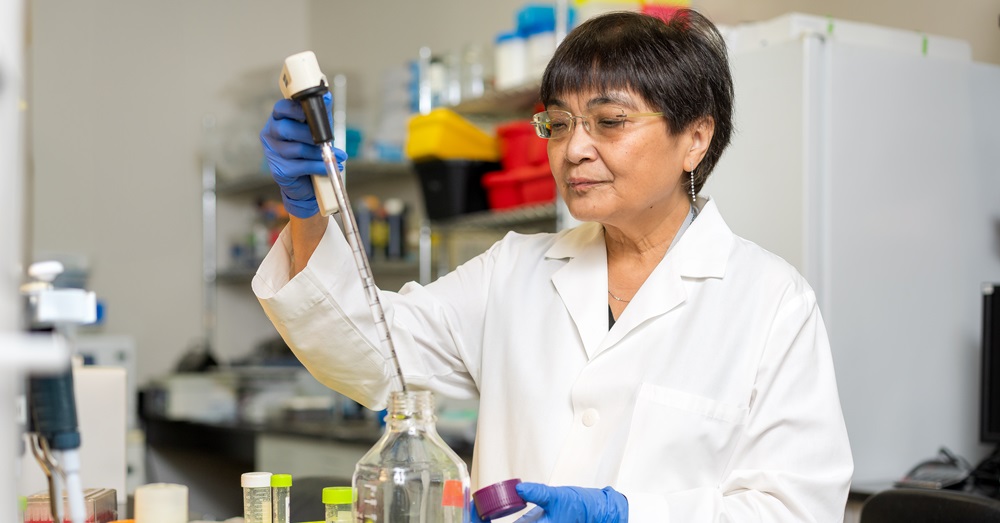TTUHSC’s Guan Receives NIH Grant to Continue Cell Transport Research

Lan Guan, M.D., Ph.D.
To help fill in some of the knowledge gaps related to cell transporters and transport mechanisms, especially secondary active transporters, the National Institute of General Medical Sciences at the National Institutes of Health (NIH) has awarded Lan Guan, M.D., Ph.D., a professor in the Department of Cell Physiology and Molecular Biophysics at the Texas Tech University Health Sciences Center (TTUHSC) School of Medicine, a five-year, $1.96 million MIRA (Maximizing Investigators’ Research Award) R35 grant (“An integrated approach to understanding the molecular mechanisms of cation-coupled transport”). MIRA grants seek to provide investigators with greater stability and flexibility to enhance the chance for important breakthroughs.
Secondary active transport coupled to cations (positively charged chemicals) is a mechanism by which molecules and ions are transported across a membrane via a favorable electrochemical energy gradient. This process plays a critical role in many aspects of cell physiology and biochemistry. It also is involved in many serious diseases such as cystic fibrosis and diabetes.
Decades of effort in structural biology and biochemistry have identified the architecture, folding, substrate binding and global conformational change of many transporters. However, Guan said there remains a deeply incomplete understanding of transport mechanisms and that, critically, many important mammalian transporters remain structurally and functionally uncharacterized.
Guan, who also serves as co-director of TTUHSC’s Center for Membrane Protein Research, has for years investigated fundamental questions of cation-coupled sugar symport, a type of secondary active transport. She has accomplished this by using a prototype bacterial transporter known as MelB, which is a sodium-coupled melibiose symporter. Melibiose is a metabolite typically produced by and found in the lower intestine. Symporters are one type of secondary active transport that moves two different molecules (e.g., sodium and sugar molecules) simultaneously in the same direction.

Lan Guan, M.D., Ph.D.
“In the past five years, supported by my previous NIH R01 grant, we have achieved important milestones,” Guan said. “This includes the determination of MelB structures in two distinct kinetic states with bound sugar or sodium and the construction of novel mechanisms of symport utilizing structural, functional, biochemical and biophysical methods.”
With this MIRA grant, Guan’s lab team will apply the accumulated experience and these successful methods further over the next five years and expand their research to include the study of SLC6A14, a mammalian sodium-coupled epithelial amino acid co-transporter involved in cancer and several other chronic diseases. Guan acknowledged her new department chair, Michael Wiener, Ph.D., a well-known membrane biophysicist, for his strong support of her research programs.
“We have made critical breakthroughs and have succeeded in expressing, purifying and functionally reconstituting SLC6A14,” Guan said. “The use of purified SLC6A14 is a critical complement for validating the published data from cell-based assays where other amino acid transporters may be present with SLC6A14.”
The state-of-the-art microscopic technique known as CryoEM will be used to paint a more accurate picture of molecules — and impart a greater understanding of biological function — because it allows images of frozen molecules for 3D high-resolution construction without using crystallization. Single-particle analysis is a robust structural biology technique that uses the images obtained from a cryo-transmission electron microscope to generate the 3D structure of proteins.
“Our targeted structures of SLC6A14, combined with results from other approaches we regularly utilize, will provide insight into its broad substrate specificity and inhibitory mechanisms by its inhibitor,” Guan said. “This is an important input for the development of potential inhibitors for applications in cancer therapy.”
Guan’s lab also will use nanobodies or binding proteins obtained from different scaffolds to stabilize MelB at specific states and then determine the structure of each using CryoEM. Biochemically speaking, Guan said these stabilized states will enable a unique and better understanding of the conformational dynamics underlying substrate binding to MelB symporter.
“The expected new structures and functional studies of both sodium-coupled nutrient symporters SLC6A14 and MelB will provide critical insight into the molecular basis of ion-coupled transport and coupling mechanisms,” Guan said. “This research can significantly impact the development of new therapeutic strategies for a broad range of chronic diseases, including cancer.”
Related Stories
TTUHSC Cancer Researcher Honored by National Academy of Inventors
C. Patrick Reynolds, M.D., Ph.D., director of the School of Medicine Pediatric Cancer Research Center at TTUHSC, has dedicated his life as a researcher to developing treatments for childhood cancers.
TTUHSC’s Hudson Set to Serve as President for Society of Clinical Research Associates
The Society of Clinical Research Associates (SOCRA) has elected Texas Tech University Health Sciences Center’s (TTUHSC) Catherine Hudson, Dr.P.H., as its president for 2025-2026.
Clinical Research Institute a Source of Pride for Retiring Griswold
Upon his retirement, John Griswold, M.D., reflects on the Clinical Research Institute and what it has achieved.
Recent Stories
Making Mental Health a Priority in the New Year
Sarah Mallard Wakefield, M.D., a psychiatrist with Texas Tech Physicians, talks about strategies to combat widespread and growing anxiety.
TTUHSC Cancer Researcher Honored by National Academy of Inventors
C. Patrick Reynolds, M.D., Ph.D., director of the School of Medicine Pediatric Cancer Research Center at TTUHSC, has dedicated his life as a researcher to developing treatments for childhood cancers.
TTUHSC School of Nursing Celebrates 10 Years of the Veteran to BSN Program
The TTUHSC School of Nursing recognized the 10-year anniversary of the Veteran to Bachelor of Science in Nursing (VBSN) program during the fall 2025 commencement ceremonies held Dec. 13 in Lubbock, Texas.
